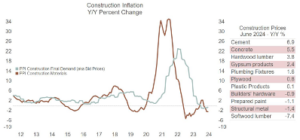by Ralph Flores, Economist at Dodge Construction Network
For June 2024, the U.S. Bureau of Labor Statistics reported a 0.2% increase in the PPI for final demand, seasonally adjusted. This follows a stagnant May and a 0.5% increase in April. The June rise was driven primarily by a 0.6% increase in final demand services, while the index for final demand goods saw a decrease of 0.5%. Over the 12-month period ending in June, the final demand index rose by 2.6% on an unadjusted basis, marking the largest year-over-year increase since March 2023.
The services sector saw notable movements, particularly a 1.9% jump in margins for final demand trade services, influenced by a 3.7% rise in machinery and vehicle wholesaling. However, the decline in prices for final demand goods, especially with a 2.6% drop in the energy index and a 5.8% decrease in gasoline prices, signals easing cost pressures in energy-dependent sectors. This decline in energy prices could alleviate some of the price pressures on materials, potentially stabilizing material costs in the near term. Still, the increase in service costs indicates that overall project costs might not see a significant reduction.
These fluctuations underscore ongoing inflationary pressures in the economy, foreshadowing potential price hikes for consumers in the near future as producers transfer their increased costs to retailers and, ultimately, to consumers. In this context, it seems likely that the Federal Reserve won’t consider reducing interest rates until the latter part of the year. Once they decide to cut rates, it’s probable that they would only do so twice at most and only if it is deemed necessary to balance inflation and economic growth effectively. As construction materials prices typically lead to bid price changes, recent trends in the PPI for construction materials indicate that bid prices are likely to experience upward pressure in the coming months. However, this increase is expected to range between 2% and 4% rather than reaching the levels seen immediately following the pandemic. Understanding these dynamics will be crucial for industry stakeholders to navigate the evolving landscape effectively.

